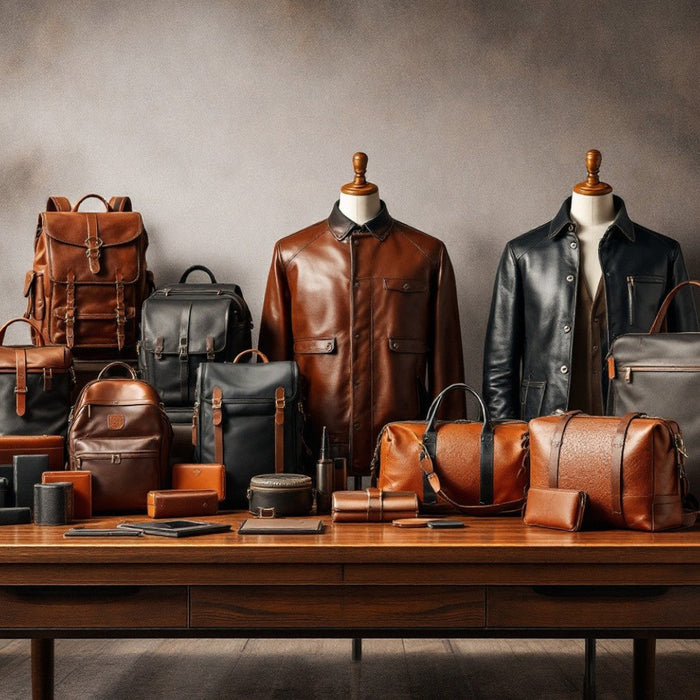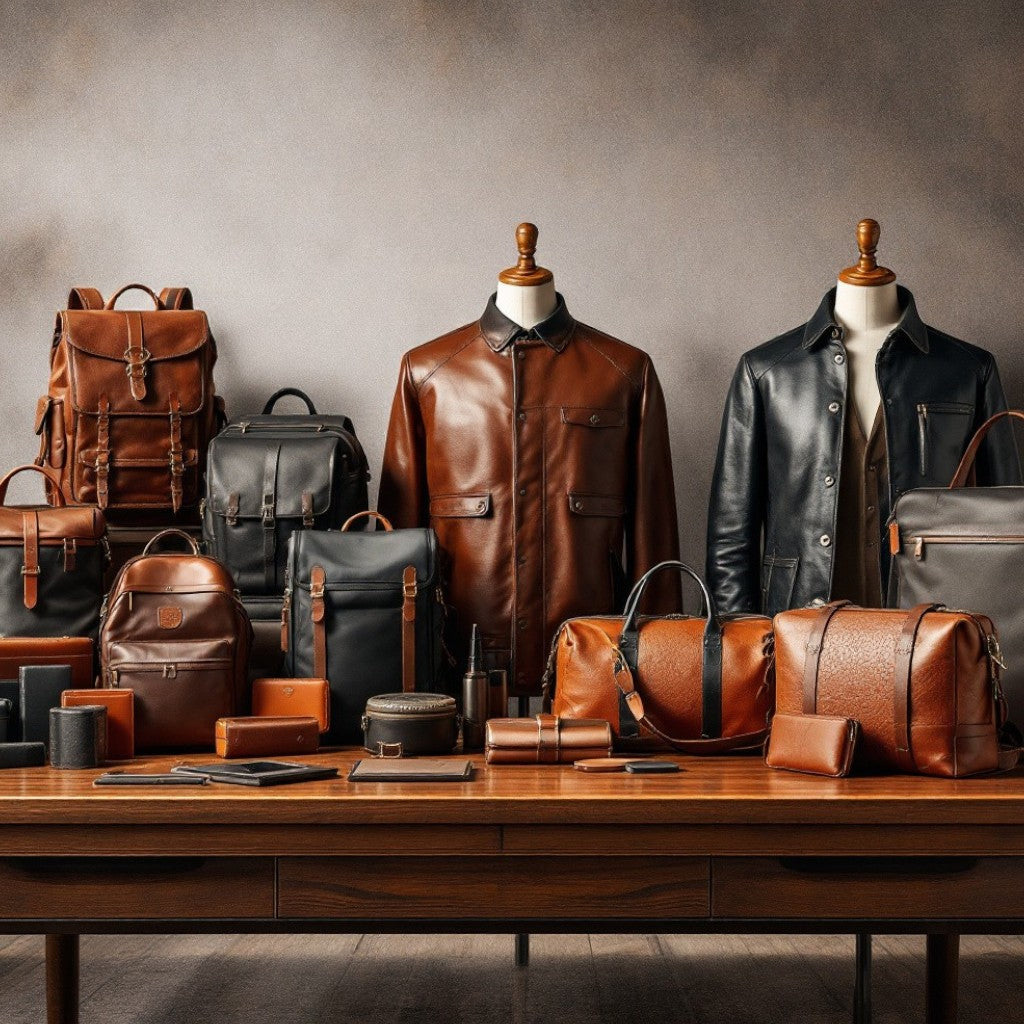
Masters of Hide and Time: The Ancient Art of Leather Craftsmanship in Modern America
Share
In a world where machines can produce a thousand wallets in the time it takes a master craftsman to stitch one by hand, why does handcrafted leather command such reverence? The answer lies not just in the final product, but in the accumulated wisdom of techniques passed down through generations—skills that transform raw hide into heirloom-quality pieces that grow more beautiful with each passing year.
At Wyoming Jack, our craftsmen represent an unbroken chain of knowledge stretching back centuries. When they select a hide for your leather briefcase, they're applying the same visual assessment skills that medieval guild masters used to evaluate pelts. When they hand-stitch a leather wallet, their fingers follow patterns refined by countless artisans who understood that some things simply cannot be rushed.
This isn't nostalgia masquerading as craftsmanship—it's the recognition that certain human skills produce results that no machine can replicate, creating pieces that bear the unmistakable mark of conscious creation rather than unconscious manufacture.
The Alchemy of Tanning: Where Science Meets Artistry
Long before chemistry was a formal science, leather artisans were master chemists, transforming perishable skin into permanent material through processes that bordered on magic. Traditional vegetable tanning—still used for the finest leather goods—requires understanding the complex interactions between tannins, time, temperature, and hide structure.
A master tanner can assess a hide's potential with a glance, determining which pieces will develop the rich patina perfect for a leather duffle bag and which possess the tight grain structure ideal for a leather journal cover. This intuitive assessment, developed through decades of handling thousands of hides, cannot be programmed into any machine.
"A hide tells its story to those who know how to listen. Every mark, every grain pattern, every slight variation speaks to how this piece should be used." — Master tanner at Wyoming Jack
The Patience of Vegetable Tanning
Modern chrome tanning can process hides in days, but vegetable tanning requires months. The hides spend weeks in carefully tended pits, slowly absorbing tannins from oak, chestnut, and other tree barks. This patience yields leather with characteristics that rushed processes cannot achieve—deeper color penetration, superior aging properties, and the ability to develop that coveted patina that makes a leather messenger bag more beautiful after years of use than when it was new.
The tanner's skill lies not just in knowing the process, but in reading the leather's progress. When to move hides to stronger tanning solutions, how to adjust for seasonal variations in temperature and humidity, when the leather has achieved the perfect balance of flexibility and durability—these decisions require human judgment honed by years of experience.
The Geography of Grain: Reading Leather Like a Map
To an untrained eye, full-grain leather appears uniform, but craftsmen see a topographic map of possibilities. Different areas of a hide possess unique characteristics—the shoulder region offers maximum durability for leather boots, while the belly area provides the suppleness perfect for leather gloves.
Master craftsmen plan their cuts like chess players thinking several moves ahead. They position high-stress areas like handle attachments in the strongest sections of the hide, reserve the most attractive grain patterns for visible surfaces, and use less perfect areas for internal components where strength matters more than appearance.
The Art of Hide Utilization
Efficient hide utilization separates master craftsmen from competent technicians. Where mass production discards significant portions of each hide as unsuitable, skilled artisans find perfect applications for seemingly flawed sections. A natural scar becomes character in a leather knife roll designed for a professional chef who values authenticity over perfection.
This holistic approach to materials reflects deeper philosophical differences between craft and manufacturing. Craftsmen work with leather as a partner, adapting their designs to highlight natural characteristics rather than forcing standardization that wastes precious materials.
Hand Tools and Human Hands: The Irreplaceable Combination
Walk into a traditional leather workshop and you'll find tools that would be familiar to craftsmen from centuries past. The head knife for rough cutting, the round knife for precise curves, the edge beveler that creates those perfectly angled edges on a leather briefcase—these tools require human hands to guide them, human eyes to judge their work, and human experience to know when the cut is perfect.
Modern cutting machines can follow programmed patterns with mechanical precision, but they cannot adjust for the subtle variations in thickness, grain direction, and natural characteristics that make each piece of leather unique. A craftsman's hand, guided by decades of experience, unconsciously adjusts pressure and angle to work with the leather rather than against it.
The Rhythm of Hand-Stitching
Perhaps nowhere is the difference between craft and manufacture more evident than in stitching. Machine stitching creates uniform, efficient seams, but hand-stitching creates what craftsmen call "living seams"—stitches that move and adjust with the leather, creating joints that actually strengthen over time rather than weakening.
The saddle stitch, used in the finest leather belts and leather holsters, involves two needles working simultaneously from opposite directions. This technique creates a seam where if one thread breaks, the remaining thread continues to hold the joint together—a fail-safe that machine stitching cannot provide.
The Language of Leather: Understanding Quality Indicators
Experienced craftsmen communicate in a language of subtle quality indicators that untrained eyes cannot detect. The feel of properly conditioned leather, the sound of quality when tapped, the way light reflects off perfectly finished edges—these sensory cues guide decision-making throughout the crafting process.
When selecting leather for a leather travel bag that must withstand years of airport handling, craftsmen assess not just current condition but aging potential. They can predict how the leather will respond to stress, how the color will develop, and where wear patterns will emerge based on subtle characteristics invisible to untrained eyes.
The Touch Test
No machine can replicate the human sense of touch for leather assessment. Experienced craftsmen can determine leather thickness to within thousandths of an inch by touch alone, assess oil content by feel, and detect structural flaws that would compromise durability. This tactile knowledge, developed through handling thousands of pieces, guides every cut and construction decision.
The temperature of leather under their hands tells craftsmen about moisture content. The resistance to stretching reveals fiber structure. The way edges respond to burnishing indicates how the finished piece will age. These subtle communications between craftsman and material cannot be digitized or automated.
Regional Traditions: American Leather Craftsmanship Heritage
American leather craftsmanship draws from diverse traditions—Native American techniques for working with buffalo hide, European guild methods brought by immigrants, and innovations born from frontier necessity. This fusion created distinctly American approaches to leather working that emphasize functionality and durability over pure decoration.
The cowboy tradition, in particular, influenced American leather craftsmanship profoundly. When your life might depend on your gear, every stitch mattered. This life-or-death standard for quality became embedded in American leather craft tradition, producing pieces like leather gun cases and leather gun slings built to perform under extreme conditions.
The Workshop Apprentice System
Traditional leather craftsmanship knowledge transfers through apprenticeship—a process that typically takes five to seven years to produce a competent craftsman and decades to develop true mastery. This extended timeline reflects the complexity of skills required: technical proficiency with tools, artistic vision for design, material science understanding for leather behavior, and business acumen for sustainable craftsmanship.
Modern apprenticeship programs at companies like Wyoming Jack maintain this tradition, pairing experienced craftsmen with eager students who learn not just techniques but the deeper philosophy of working with natural materials. These relationships often span decades, creating communities of practice that preserve and evolve traditional methods.
Innovation Within Tradition: Modern Improvements to Ancient Methods
The finest craftsmen don't simply replicate historical techniques—they refine and improve them using modern understanding of materials science and ergonomics. Computer-aided design might help optimize pattern layouts for hide utilization, but the actual cutting still requires human judgment and hand skills.
Modern thread materials offer superior strength and durability, but hand-stitching techniques remain unchanged because they produce superior results. New edge-finishing compounds create more durable surfaces, but application still requires the craftsman's experienced eye to judge proper coverage and curing.
Selective Technology Integration
Master craftsmen embrace technology that enhances rather than replaces human skills. Precision measuring tools ensure accurate cuts, improved lighting reduces eye strain during detailed work, and better workshop ventilation protects artisan health. However, the core skills—leather selection, pattern optimization, hand-stitching, and edge finishing—remain fundamentally human activities.
This selective approach to modernization reflects understanding that certain technologies improve craft while others diminish it. A laser engraver might create precise personalization on a leather padfolio, but the initial leather preparation and final finishing require traditional hand techniques.
The Economics of Artisan Production
Handcrafted leather goods operate in different economic territory than mass-produced alternatives. Where factories optimize for speed and volume, artisan workshops optimize for quality and longevity. A master craftsman might complete only two or three leather briefcases per week, but each will outlast dozens of machine-made alternatives.
This economic model requires customers who understand value beyond initial price. When a handcrafted leather journal serves faithfully for decades while mass-produced alternatives require frequent replacement, the economics favor craftsmanship over convenience.
The True Cost of Quality
Artisan leather goods carry the true cost of sustainable production: fair wages for skilled craftsmen, time for proper processes, premium materials, and workshop overhead that prioritizes quality over efficiency. This transparency in pricing contrasts sharply with mass production that externalizes many costs—environmental degradation, worker exploitation, and waste disposal—onto society.
When customers choose handcrafted leather dopp kits over mass-produced alternatives, they're voting for economic models that support skilled workers, environmental sustainability, and product longevity over short-term savings.
The Craftsman's Philosophy: Beyond Mere Production
Master leather craftsmen often describe their work in philosophical terms that transcend mere manufacturing. They see themselves as stewards of tradition, guardians of quality, and partners with natural materials in creating objects that honor both function and beauty.
This philosophical approach influences every aspect of production. When creating a leather portfolio for a young professional, craftsmen consider not just immediate needs but how the piece will age and adapt as the owner's career develops. They build in potential for patina development, structural durability for decades of use, and timeless design that won't become dated.
The Meditation of Craft
Many craftsmen describe leather working as meditative practice. The repetitive nature of hand-stitching, the focus required for precise cutting, and the patience needed for proper finishing create mental states similar to meditation. This psychological aspect of craftsmanship influences product quality in ways that rushed production cannot replicate.
When a craftsman approaches each leather backpack with meditative attention, small details receive the same care as major construction elements. Edge finishing becomes not just functional necessity but artistic expression. Hardware placement considers not just engineering requirements but aesthetic harmony.
Identifying Handcrafted Quality: What to Look For
Distinguishing genuine handcrafted leather from machine production requires understanding subtle quality indicators that mass production cannot replicate. Hand-stitching shows slight variations in tension and spacing that create character rather than flaws. Edge finishing on quality pieces shows the slight irregularities of human application rather than mechanical uniformity.
The overall proportions of handcrafted pieces often feel more natural and balanced than computer-optimized designs. Craftsmen unconsciously adjust dimensions based on visual harmony and tactile satisfaction rather than mathematical precision, creating pieces that feel "right" in ways that resist analysis.
The Signature of Human Hands
Experienced buyers learn to recognize the signature characteristics of different workshops and individual craftsmen. The particular way one artisan shapes handle curves, another's approach to corner reinforcement, or a workshop's distinctive edge-finishing technique become identifiers as unique as handwriting.
These individual characteristics make handcrafted pieces more valuable over time rather than less. A leather messenger bag bearing the distinctive craftsmanship signatures of a particular artisan becomes increasingly rare and treasured as that craftsman's career progresses.
Preserving Craft Knowledge in the Digital Age
The challenge facing traditional craftsmanship involves preserving accumulated knowledge in an era that values speed over depth. Master craftsmen approaching retirement possess skills and understanding that took lifetimes to develop—knowledge that could disappear if not properly transferred to younger generations.
Forward-thinking workshops document traditional techniques through video, detailed written procedures, and intensive apprentice programs. However, the most crucial knowledge—the intuitive understanding of materials and processes—still requires years of hands-on experience to develop.
The Renaissance of Craft Appreciation
Paradoxically, the digital age has created renewed appreciation for handcrafted goods. Consumers overwhelmed by mass-produced uniformity increasingly seek objects with character, history, and individual personality. This trend supports artisan workshops and encourages young people to pursue traditional craft careers.
Social media allows craftsmen to share their work and processes with global audiences, creating markets that support specialized skills. A master creating custom leather knife rolls for professional chefs can now reach culinary professionals worldwide rather than relying on local demand alone.
The Environmental Case for Craftsmanship
Handcrafted leather goods represent sustainable alternatives to disposable consumer culture. The longevity of properly made pieces reduces resource consumption, while traditional tanning methods often have lower environmental impact than industrial processes. Additionally, local craft production eliminates transportation emissions associated with global manufacturing.
When customers choose a handcrafted leather tote bag that will serve for decades over synthetic alternatives requiring frequent replacement, they're making environmental choices as much as quality choices.
The Circular Craft Economy
Traditional craft workshops often maintain repair services for their products, creating circular economy models where goods are maintained, refurbished, and ultimately recycled rather than discarded. A well-made leather belt can be resoled, re-stitched, and refinished multiple times, extending useful life far beyond mass-produced alternatives.
This service model creates ongoing relationships between craftsmen and customers, ensuring quality standards through reputation and repeat business rather than marketing and planned obsolescence.
The Future of Leather Craftsmanship
The future of leather craftsmanship likely involves selective integration of technology with traditional methods rather than wholesale replacement. 3D scanning might help optimize hide utilization, but cutting will remain a hand skill. Computer-controlled tools might improve precision, but design and finishing will continue requiring human creativity and judgment.
The growing appreciation for authentic, durable goods suggests bright prospects for skilled craftsmen willing to maintain traditional standards while selectively embracing helpful innovations. As mass production becomes more automated and impersonal, handcrafted goods become more valuable for their human connection and individual character.
Cultivating the Next Generation
Ensuring craft continuation requires attracting young people to careers that offer creative satisfaction, economic sustainability, and connection to traditional skills. This means not just teaching techniques but helping new craftsmen understand the deeper satisfactions of creating lasting beauty from natural materials.
Programs that combine traditional apprenticeships with modern business training prepare craftsmen for contemporary markets while preserving essential skills. The goal is evolution, not preservation—maintaining craft quality while adapting to current needs and opportunities.
In an age of artificial intelligence and robotic manufacturing, the human hands that transform raw hide into heirloom-quality leather goods represent something irreplaceable—the intersection of traditional wisdom, individual creativity, and intimate understanding of natural materials that no machine can replicate.
When you choose a handcrafted leather briefcase or leather journal, you're not just buying an accessory—you're supporting an ancient tradition, encouraging sustainable production methods, and acquiring an object that bears the unmistakable mark of human consciousness applied to natural materials with skill, patience, and respect.
Learn more about our craftsmen and their techniques on our about us page, or explore our signature collection to experience the difference that genuine craftsmanship makes. Because in a world of mass production, the artisan's touch remains irreplaceable—and more valuable than ever.








